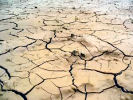Global Shale Gas Development: Water Availability & Business Risks by Paul Reig, Tianyi Luo and Jonathan N. Proctor

Shale resources are unevenly distributed worldwide and, for the most part, not located where freshwater is abundant. For example, China, Mexico, and South Africa have some of the largest technically recoverable shale gas resources (based on estimates from the U.S. Energy Information Administration), but face high to extremely high water stress where the shale is located.
This report reveals that lack of water availability could curtail shale development in many places around the world:
-
38 percent of shale resources are in areas that are either arid or under high to extremely high levels of water stress;
-
19 percent are in areas of high or extremely high seasonal variability; and
-
15 percent are in locations exposed to high or extremely high drought severity.
Furthermore, 386 million people live on the land over these shale plays, and in 40 percent of the shale plays, irrigated agriculture is the largest water user. Thus drilling and hydraulic fracturing often compete with other demands for freshwater, which can result in conflicts with other water users. This is particularly true in areas of high baseline water stress, where over 40 percent of the available water supplies are already being withdrawn for agricultural, municipal, or industrial purposes.
The 20 countries with the largest shale gas or tight oil resources that are recoverable using currently available technology are shown in Table ES2 (Download the executive summary here).
-
Eight of the top 20 countries with the largest shale gas resources face arid conditions or high to extremely high baseline water stress where the shale resources are located; this includes China, Algeria, Mexico, South Africa, Libya, Pakistan, Egypt, and India.
-
Eight of the top 20 countries with the largest tight oil resources face arid conditions or high to extremely high baseline water stress where the shale resources are located; this includes China, Libya, Mexico, Pakistan, Algeria, Egypt, India, and Mongolia.
Hydrological conditions vary spatially and seasonally across shale plays, with variation among plays, within plays, and throughout the year. This variation makes companies’ ability to meet the freshwater demands for hydraulic fracturing and drilling highly unpredictable, and estimates based on previous experience not always accurate in new shale formations. This high level of uncertainty can lead to business risks for companies exploring new areas for development. Furthermore, public concern over increased competition and impacts on freshwater availability can threaten a company’s social license to operate and lead to changes in government regulations that could impact both short- and long-term investments.
WRI says that its findings
indicate that companies developing shale resources internationally are likely to face serious challenges to accessing freshwater in many parts of the world. These challenges highlight a strong business case for strategic company engagement in sustainable water management at local and regional levels. They also point to a need for companies to work with governments and other sectors to minimize environmental impacts and water resources depletion.
But it appears that WRI accepts the unsustainable practice of fracking. (See http://candobetter.net/node/3757 and http://candobetter.net/taxonomy/term/3020Many people and countries in the world do not.
-
38 percent of the world’s shale resources face high to extremely high water stress or arid conditions.
-
386 million people live on land above shale plays—increased competition for water and public concern over hydraulic fracturing is more likely in densely populated areas.
-
In China, 61 percent of shale resources face high water stress or arid conditions.
-
In Argentina, 72 percent of shale resources face low to medium water stress.
-
In the United Kingdom, 34 percent of shale plays face high water stress or arid conditions.

Recent comments